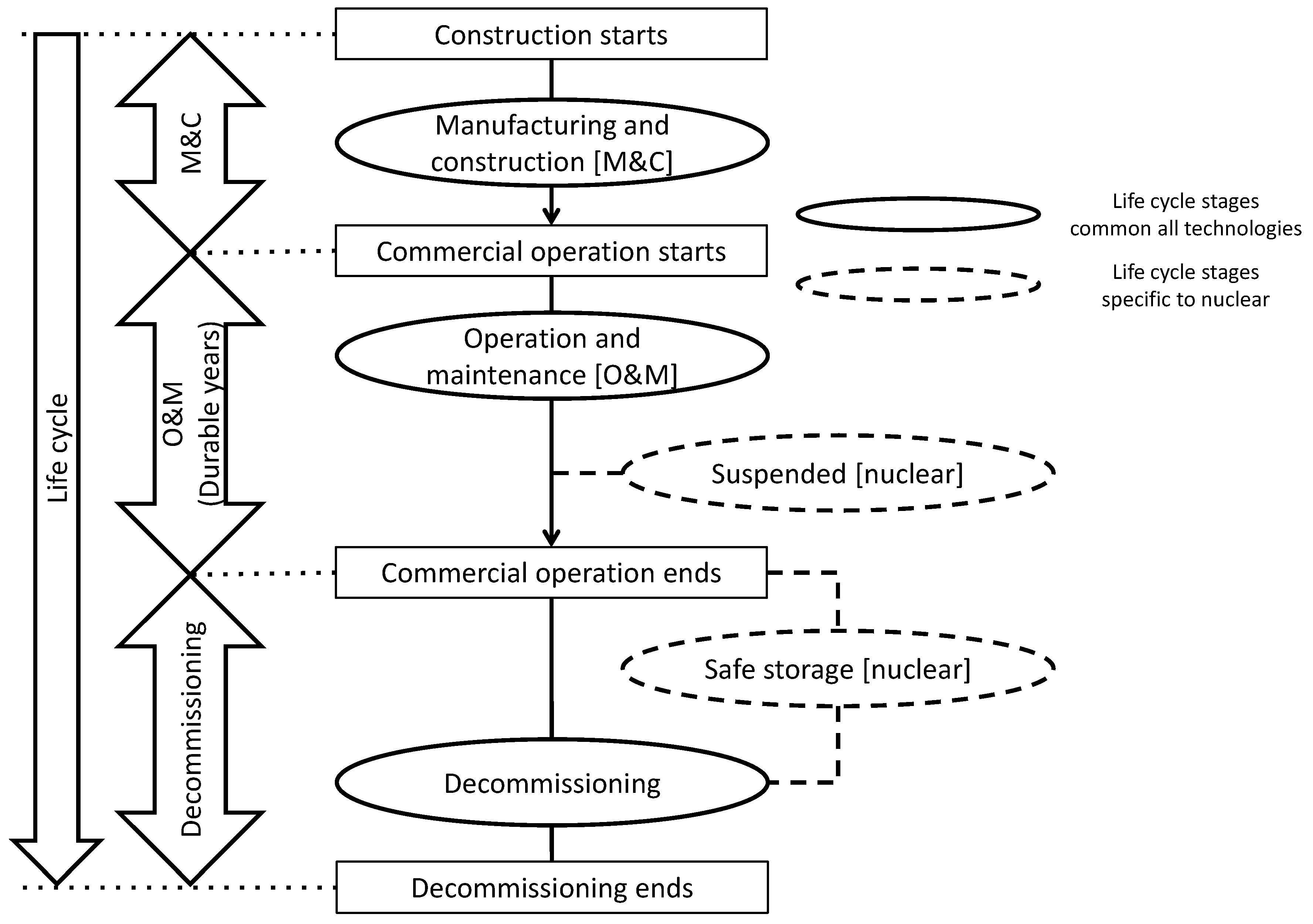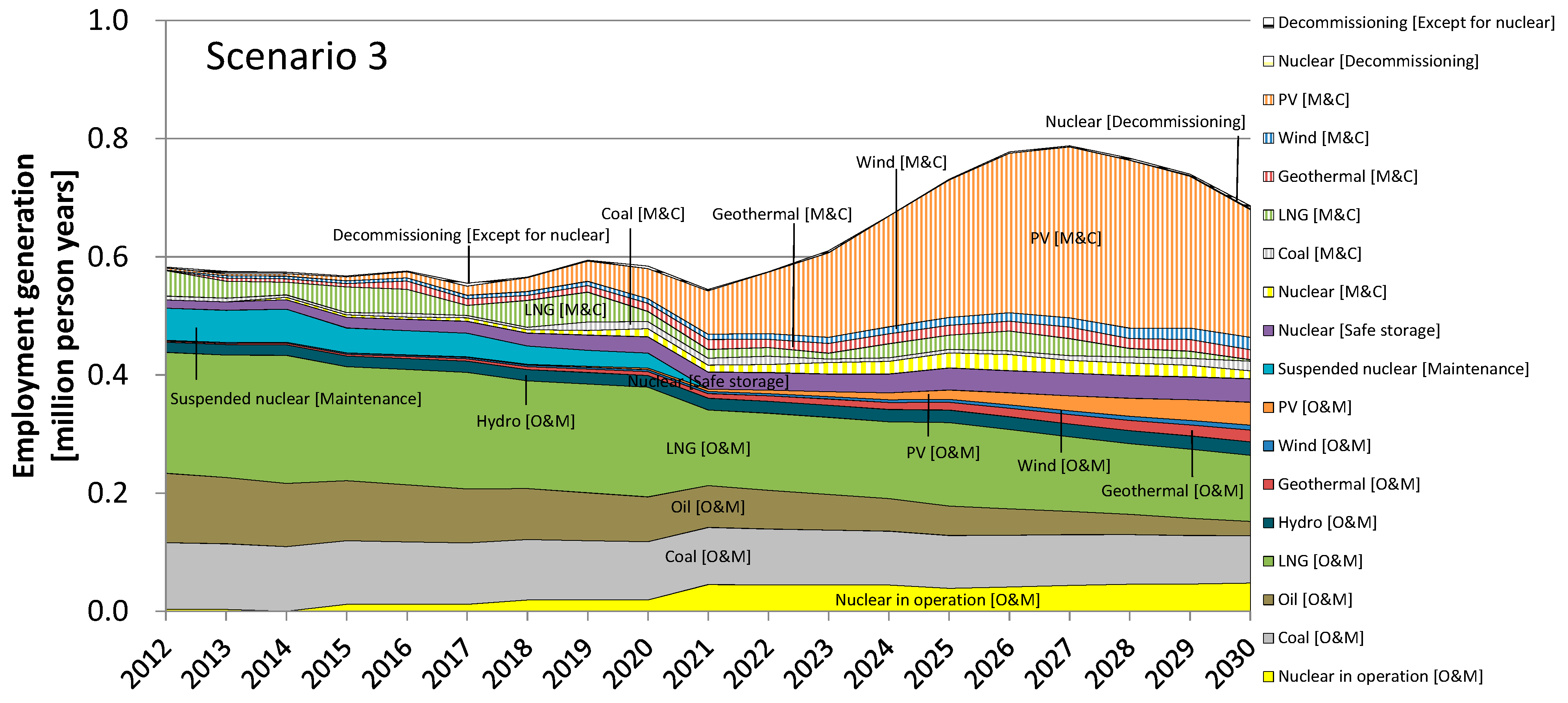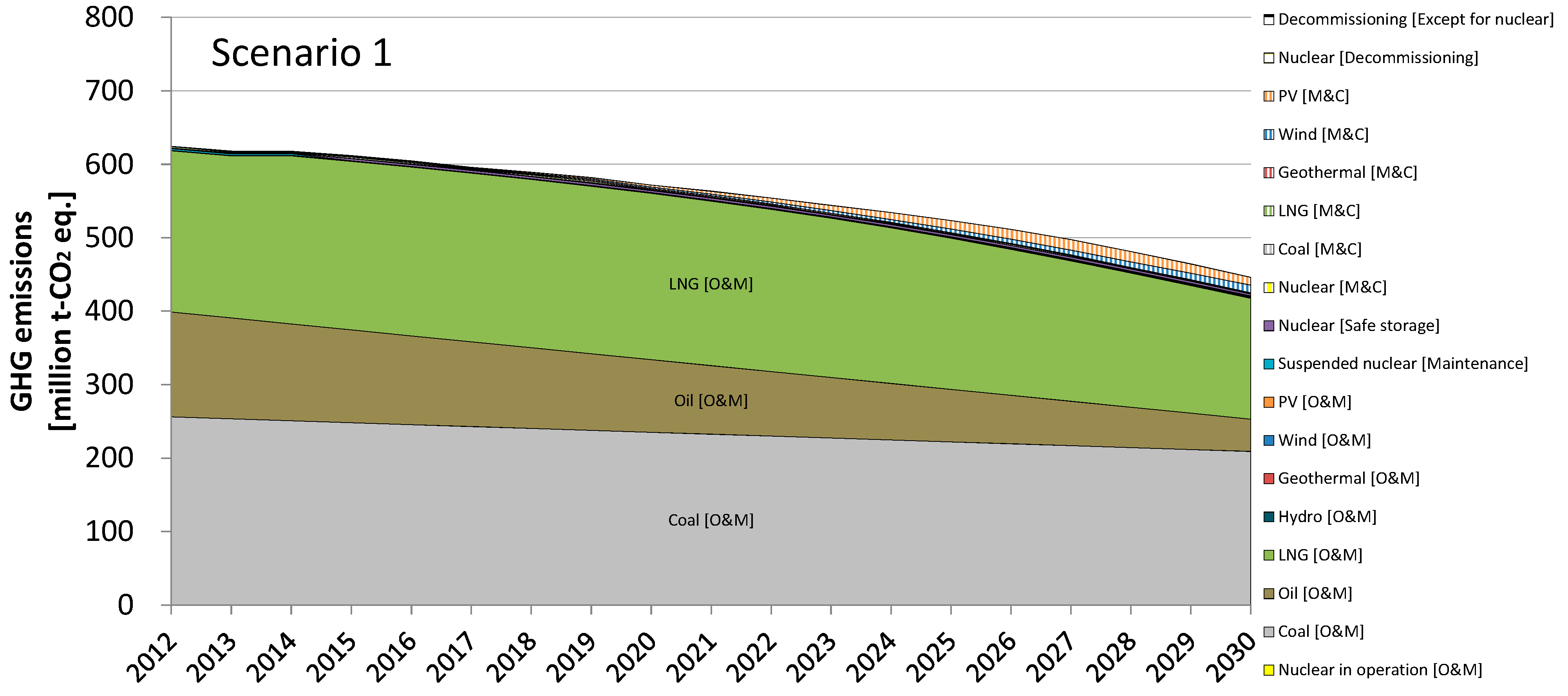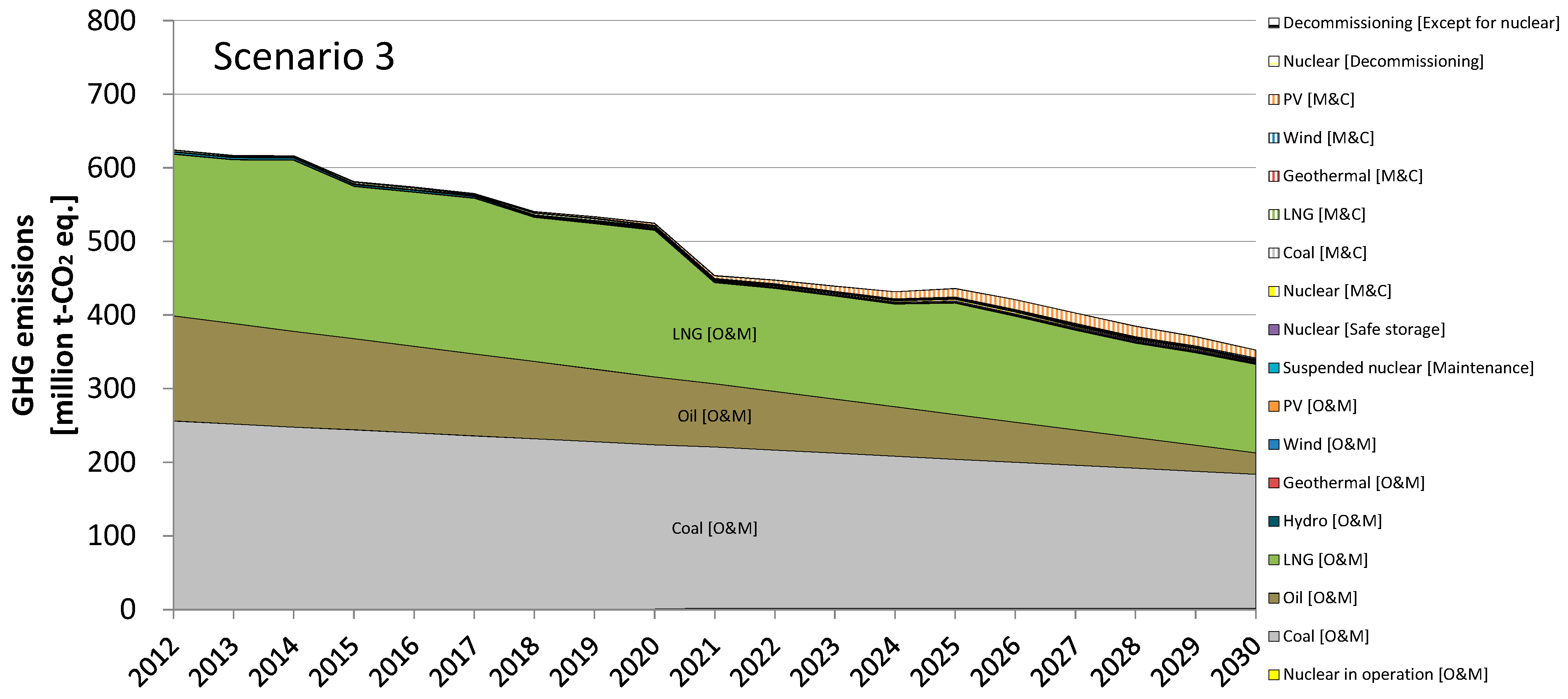Establishing a Framework for Evaluating Environmental and Socio-Economic Impacts by Power Generation Technology Using an Input–output Table—A Case Study of Japanese Future Electricity Grid Mix
Abstract
:1. Introduction
2. Socio-Economic and Environmental Impact Estimations

3. Case Study Assumptions and Scenarios
3.1. System Boundary

3.2. Power Generation Technology Specifications
| 2005 Prices: Million JPY * | Nuclear | Coal | Oil | Liquefied Natural Gas (LNG) | Large-Scale Hydro | Geothermal | Wind | PV | |
|---|---|---|---|---|---|---|---|---|---|
| Generation capacity | (kW) | 1,150,000 | 650,000 | 530,000 | 530,000 | - | 50,000 | 2000 | 3.5 |
| Load factor | (%) | 80 | - | - | - | - | 80 | 20 | 12 |
| Internal consumption rate | (%) | 4.3 | - | - | - | - | 5.0 | 5.0 | 0 |
| Manufacturing and construction cost | (million yen/MW) | 123 | 130 | - | 92 | - | 583 | 150 | 486 |
| Operation and maintenance cost | (million yen/GWh) | 5.4 | 5.4 | 9.7 | 6.4 | 4.2 | 12.8 | 7.1 | 25.9 |
| Decommissioning cost | (million yen/MW) | 18.4 | 6.5 | 4.6 | 4.6 | - | 29.2 | 7.5 | 24.3 |
| Manufacturing and construction | (years) | 7 | 4 | - | 2 | - | 1 | 1 | 1 |
| Operation and maintenance | (years) | 40 | 40 | 30 | 30 | - | 40 | 25 | 25 |
| Safe storage | (years) | 15 | - | - | - | - | - | - | - |
| Decommissioning | (years) | 3 | 1 | 1 | 1 | - | 1 | 1 | 1 |
3.3. Scenario Settings

3.3.1. Nuclear
| Scenario 1 | Scenario 2 | Scenario 3 | |
|---|---|---|---|
| Existing power plants | Resumed operation is aborted and all existing power plants are decommissioned after a safe storage period. |
| |
| New construction of power plants | All new construction and replacement are aborted. | All new construction and replacement are aborted. |
|
| |||
| Replacement of power plants |
| ||
| |||
3.3.2. Three Renewables (Geothermal, Wind and PV)
| a | b | c | R2 | ||
|---|---|---|---|---|---|
| Geothermal | Scenario 1 | 6.5 | 546.5 | 0.3 | 0.80 |
| Scenario 2 | 6.5 | 257.9 | 0.2 | 0.84 | |
| Scenario 3 | 6.5 | 168.0 | 0.2 | 0.87 | |
| Wind | Scenario 1 | 414.8 | 1362.4 | 0.2 | 0.87 |
| Scenario 2 | 414.8 | 946.8 | 0.2 | 0.88 | |
| Scenario 3 | 414.8 | 490.4 | 0.1 | 0.90 | |
| PV | Scenario 1 | 72.2 | 69681.3 | 0.4 | 0.68 |
| Scenario 2 | 72.2 | 69681.3 | 0.4 | 0.68 | |
| Scenario 3 | 72.2 | 69681.3 | 0.4 | 0.68 | |
3.3.3. Large-Scale Hydro
3.3.4. Fossil Fuel (Coal, Oil and LNG)
3.4. Replacement of Power Plants
4. Results and Discussion
4.1. Employment Impact

| 2012 | Scenario 1 | Scenario 2 | Scenario 3 | |||||
|---|---|---|---|---|---|---|---|---|
| 2020 | 2030 | 2020 | 2030 | 2020 | 2030 | |||
| Total (million person years) | 0.58 | 0.64 | 0.85 | 0.58 | 0.74 | 0.58 | 0.69 | |
| Nuclear | M&C | 0% | 0% | 0% | 0% | 0% | 2% | 2% |
| O&M | 1% | 0% | 0% | 3% | 4% | 3% | 7% | |
| Suspended | 9% | 0% | 0% | 4% | 0% | 4% | 0% | |
| Safe storage | 2% | 11% | 8% | 5% | 5% | 5% | 6% | |
| Decommissioning | 0% | 0% | 0% | 0% | 0% | 0% | 0% | |
| Coal | M&C | 1% | 2% | 2% | 2% | 2% | 2% | 2% |
| O&M | 19% | 16% | 11% | 17% | 12% | 17% | 12% | |
| Oil | M&C | - | - | - | - | - | - | - |
| O&M | 20% | 13% | 4% | 13% | 3% | 13% | 3% | |
| LNG | M&C | 7% | 3% | 0% | 3% | 0% | 3% | 0% |
| O&M | 35% | 33% | 18% | 31% | 17% | 32% | 16% | |
| Large-scale hydro | M&C | - | - | - | - | - | - | - |
| O&M | 3% | 3% | 3% | 3% | 3% | 3% | 3% | |
| Geothermal | M&C | 0% | 3% | 1% | 3% | 2% | 2% | 2% |
| O&M | 0% | 2% | 3% | 1% | 3% | 1% | 3% | |
| Wind | M&C | 0% | 4% | 15% | 3% | 10% | 1% | 3% |
| O&M | 0% | 1% | 4% | 1% | 3% | 1% | 1% | |
| PV | M&C | 1% | 8% | 25% | 9% | 29% | 9% | 31% |
| O&M | 0% | 0% | 5% | 0% | 5% | 0% | 6% | |
| Decommissioning (Except for nuclear) | 0% | 1% | 1% | 1% | 1% | 1% | 1% | |
| 100% | 100% | 100% | 100% | 100% | 100% | 100% | ||
4.2. Impacts on GHG Emissions

5. Conclusions
- The authors are currently establishing an extended IO table where the different IO structures per power generation technology are reflected by disaggregating the original IO sectors or by creating new IO sectors related to renewable energies based on detailed technological data. Although the hybrid bottom-up and IO approach for life cycle inventory analysis used in the framework established here reflects the power generation technology differences, the authors’ plan to use the extended IO table in the framework so that a wide range of potential impacts can be estimated using input coefficient matrices that are adjustable to different power generation mixes.
- The various assumptions made in the case study are based on current data, and the case study results strongly depend on these assumptions. In particular, data relating to the maintenance stage of suspended nuclear power plants and the safe storage and decommissioning stages of nuclear power plants may influence the results. A further important activity related to nuclear power not included in the case study is the back-end stages of its fuel cycle.
- Power generation by PV and wind power generation is fluctuated by the weather so that increasing supply-demand balancing capacities shall become important to assure stable power supply when such unstable power sources are connected to the grid in full-scale. Since it requires additional capital investments to production, transmission and distribution of electricity, it is necessary to include the parameters and scenarios to evaluate the environmental and socio-economic impacts associated with this capacity enhancement in our framework developed.
- Quantitative environmental and socio-economic impact information may help decision makers choose future energy systems; hence, as detailed and precise data becomes available, there is a clear need to conduct a new case study using the framework and to produce updated results. It is also important to conduct a sensitivity analysis to identify hotspots and to understand the uncertainties related to the potential environment and socio-economic impacts.
Author Contributions
Conflicts of Interest
Appendix




References
- Ministry of Economy, Trade and Industry (METI). Basic Energy Plan; METI: Tokyo, Japan, 2010.
- Ministry of Economy, Trade and Industry (METI). Basic Energy Plan; METI: Tokyo, Japan, 2014.
- Ministry of Economy, Trade and Industry (METI). Act on Special Measures Concerning the Procurement of Renewable Electric Energy by Operators of Electric Utilities; METI: Tokyo, Japan, 2012. Available online: http://www.enecho.meti.go.jp/category/saving_and_new/saiene/kaitori/2011kaitori.pdf (accessed on 28 May 2015).
- Japan Renewable Energy Foundation (JREF). Current Status and Cost of Solar Power Generation Business; JREF: Tokyo, Japan, 2014; Available online: http://jref.or.jp/images/pdf/20130628/FIT_press%20release_FIT1year_REV.pdf (accessed on 28 May 2015).
- Kimura, K.; Mano, S. Current Status and Cost of Solar Power Generation Business; Japan renewable energy foundation (JREF): Tokyo, Japan, 2013; Available online: http://jref.or.jp/images/pdf/20131220/reports_20131220.pdf (accessed on 28 May 2015).
- Japan Renewable Energy Foundation (JREF). Feed-in Tariff, Proposals for Suggestion System Design for System Design and Evaluation of First Year; JREF: Tokyo, Japan, 2013; Available online: http://jref.or.jp/images/pdf/20140110/JREF_FITProposal_10JAN2014.pdf (accessed on 28 May 2015).
- Japan Renewable Energy Foundation (JREF). Proposals for Renewable Energy Policy/feed-in Tariff; JREF: Tokyo, Japan, 2014; Available online: http://www.isep.or.jp/wp/wp-content/uploads/2014/01/ISEPpress-FIT201401221.pdf (accessed on 28 May 2015).
- United Nations (UN). Kyoto Protocol to the United Nations Framework Convention on Climate Change; UN: New York, NY, USA, 1998; Available online: http://unfccc.int/resource/docs/convkp/kpeng.pdf (accessed on 1 June 2015).
- Nakata, T. Analysis of the impacts of nuclear phase-out on energy system in Japan. Energy 2002, 27, 363–377. [Google Scholar] [CrossRef]
- Takase, K.; Suzuki, T. The Japanese energy sector: Current situation, and future paths. Energy Policy 2011, 39, 6731–6744. [Google Scholar] [CrossRef]
- Zhang, Q.; Ishihara, K.N.; Mclellan, B.C.; Tezuka, T. Scenario analysis on future electricity supply and demand in Japan. Energy 2012, 38, 376–385. [Google Scholar] [CrossRef]
- Pereira, J.P.; Parady, G.T.; Dominguez, B.C. Japan’s energy conundrum: Post-Fukushima scenarios from a life cycle perspective. Energy Policy 2014, 67, 104–115. [Google Scholar] [CrossRef]
- Organization for Economic Co-operation and Development (OECD). How’s Life: Executive Summary; OECD: Paris, France, 2013; Available online: http://www.oecdbetterlifeindex.org/ (accessed on 15 March 2015).
- Ministry of Health, Labour and Welfare (MHLW). Economic and Social System to Realize a Sustainable Society with Vitality; MHLW: Tokyo, Japan, 2010. Available online: http://www.mhlw.go.jp/stf/houdou/2r9852000000cguk-img/2r9852000000ch2y.pdf (accessed on 24 August 2015).
- Caldés, N.; Varela, M.; Santamaría, M.; Sáez, R. Economic impact of solar thermal electricity deployment in Spain. Energy Policy 2009, 37, 1628–1636. [Google Scholar] [CrossRef]
- Tourkolias, C.; Mirasgedis, S. Quantification and monetization of employment benefits associated with renewable energy technologies in Greece. Renew. Sustain. Energy Rev. 2011, 15, 2876–2886. [Google Scholar] [CrossRef]
- Markaki, M.; Belegri-Roboli, A.; Michaelides, P.; Mirasgedis, S.; Lalas, D.P. The impact of clean energy investments on the Greek economy: An input–output analysis (2010–2020). Energy Policy 2013, 57, 263–275. [Google Scholar] [CrossRef]
- Arce, R.; Mahia, R.; Medina, E.; Escribano, G. A simulation of the economic impact of renewable energy development in Morocco. Energy Policy 2012, 46, 335–345. [Google Scholar] [CrossRef]
- Ciorba, U.; Pauli, F.; Menna, P. Technical and economical analysis of an induced demand in the photovoltaic sector. Energy Policy 2004, 32, 949–960. [Google Scholar] [CrossRef]
- Lehr, U.; Nitsch, J.; Kratzat, M.; Lutz, C.; Edler, D. Renewable energy and employment in Germany. Energy Policy 2008, 36, 108–117. [Google Scholar] [CrossRef]
- Matumoto, N.; Hondo, H. Analysis on employment effects of the introduction of renewable energy technologies using an extended input-output table. J. Jpn. Inst. Energy 2011, 90, 258–267. [Google Scholar] [CrossRef]
- Hienuki, S.; Kudoh, Y.; Hondo, H. Life cycle employment effect of geothermal power generation using an extended input-output model: The Case of Japan. J. Clean. Prod. 2015, 93, 203–212. [Google Scholar] [CrossRef]
- Silalertruksa, T.; Gheewala, S.H.; Hunecke, K.; Fritsche, U.R. Biofuels and employment effects: Implications for socio-economic development in Thailand. Biomass Bioenerg. 2012, 46, 409–418. [Google Scholar] [CrossRef]
- Tsurugai, M.; Heiho, A.; Kudoh, Y.; Hondo, H. Environmental effects associated with the use of waste biomass: A Case Study of the Miura Biomass Center. J. Jpn. Inst. Energy 2013, 92, 258–267. [Google Scholar] [CrossRef]
- Hondo, H.; Kikuchi, K. Effect of local biomass project on energy balance and GHG emission: A life cycle approach. Int. J. Green Energy 2015, 12, 160–167. [Google Scholar] [CrossRef]
- Ministry of International Affairs and Communications (MIC). 2005 Input-Output Tables for Japan; MIC: Tokyo, Japan, 2011.
- Nansai, K.; Moriguchi, Y. Embodied Energy and Emission Intensity Data for Japan Using Input–Output Tables (3EID): For 2005 IO Table; Center for Global Environmental Research (CGER), National Institute for Environmental Studies: Tsukuba, Japan, 2012. Available online: http://www.cger.nies.go.jp/publications/report/d031/index.html (accessed on 6 May 2014).
- Cabinet Secretariat (CAS). Cost, etc. Verification Committee Report; CAS: Tokyo, Japan, 2011. Available online: http://www.cas.go.jp/jp/seisaku/npu/policy09/pdf/20111221/hokoku.pdf (accessed on 6 May 2014).
- Cabinet Secretariat (CAS). Estimates Sheet of Power Generation Cost; CAS: Tokyo, Japan, 2014. Available online: http://www.cas.go.jp/jp/seisaku/npu/policy09/archive02_shisan_sheet.html (accessed on 10 January 2015).
- Hondo, H.; Uchiyama, Y.; Moriizumi, Y. Evaluation of Power Generation Technologies based on Life Cycle CO2 Emissions—Re-Estimation Using the Latest Data and Effects of the Difference of Conditions; Socio-economic Research Centre Report No. Y99009; Central Research Institute of Electric Power Industry: Tokyo, Japan, 2000. [Google Scholar]
- International Energy Agency (IEA). Project Cost of Generating Electricity 2010 Edition; IEA: Paris, France, 2010. [Google Scholar]
- Hokkaido Electric Power Co., Inc. Securities Report FY 2005; Hokkaido Electric Power Co., Inc.: Hokkaido, Japan, 2006. [Google Scholar]
- Tohoku Electric Power Co., Inc. Securities Report FY 2005; Tohoku Electric Power Co., Inc.: Sendai, Japan, 2006. [Google Scholar]
- Tokyo Electric Power Co., Inc. Securities Report FY 2005; Tokyo Electric Power Co., Inc.: Tokyo, Japan, 2006. [Google Scholar]
- Hokuriku Electric Power Co., Inc. Securities Report FY 2005; Hokuriku Electric Power Co., Inc.: Toyama, Japan, 2006. [Google Scholar]
- Chubu Electric Power Co., Inc. Securities Report FY 2005; Chubu Electric Power Co., Inc.: Nagoya, Japan, 2006. [Google Scholar]
- Kansai Electric Power Co., Inc. Securities Report FY 2005; Kansai Electric Power Co., Inc.: Osaka, Japan, 2006. [Google Scholar]
- Chugoku Electric Power Co., Inc. Securities Report FY 2005; Chugoku Electric Power Co., Inc.: Hiroshima, Japan, 2006. [Google Scholar]
- Shikoku Electric Power Co., Inc. Securities Report FY 2005; Shikoku Electric Power Co., Inc.: Takamatsu, Japan, 2006. [Google Scholar]
- Kyushu Electric Power Co., Inc. Securities Report FY 2005; Kyushu Electric Power Co., Inc.: Fukuoka, Japan, 2006. [Google Scholar]
- Okinawa Electric Power Co., Inc. Securities Report FY 2005; Okinawa Electric Power Co., Inc.: Naha, Japan, 2006. [Google Scholar]
- Ministry of the Environment (MoE). Study of Potential for the Introduction of Renewable Energy (FY2010); MoE: Tokyo, Japan, 2011.
- Yoshioka, K.; Uchiyama, Y.; Hondo, H.; Suga, M. An application of the input-output approach in environmental analysis: Estimating the CO2 emission of fossil-fired and nuclear power generation. Application of Input-output tables for environmental analysis (5). Input-Output Anal. Innov. Tech. 1994, 5, 5–15. [Google Scholar] [CrossRef]
- Ministry of the Environment (MoE). Greenhouse Gas Emissions Calculation and Reporting Manual ver.3.4; MoE: Tokyo, Japan, 2013.
- Cabinet Office, Government of Japan (CAO). Deflators (Calendar Year: Changes from the Previous Year); CAO: Tokyo, Japan, 2012. Available online: http://www.esri.cao.go.jp/en/sna/data/sokuhou/files/2012/qe122/gdemenuea.html (accessed on 6 May 2014).
- World Bank. Official Exchange Rate (LCU per US$, Period Average). Available online: http://data.worldbank.org/indicator/PA.NUS.FCRF?page=1 (accessed on 29 September 2015).
- Chubu Electric Power Co. Inc. Construction Cost of Tsunami Countermeasures in Hamaoka Nuclear Power Station; Chubu Electric Power Co. Inc.: Nagoya, Japan, 2012; Available online: http://www.chuden.co.jp/corporate/publicity/pub_release/press/3180836_6926.html (accessed on 4 December 2014).
- Federation of Electric Power Companies of Japan (FEPC). Data of Power Generation; FEPC: Tokyo, Japan, 2014; Available online: http://www.fepc.or.jp/library/data/index.html (accessed on 4 December 2014).
- Chubu Electric Power Co. Inc. Schedule of Decommissioning Plan of Hamaoka Units 1 and 2. Available online: http://www.chuden.co.jp/resource/energy/haishi_haishi-schedule_2.pdf (accessed on 4 December 2014).
- Takahashi, M.; Nagata, Y. Any Stagnation of Nuclear Power is the Extent to Affect the Electricity Prices? Socio-economic Research Centre Discussion Paper 11022; Central Research Institute of Electric Power Industry: Tokyo, Japan, 2011. [Google Scholar]
- Japan Photovoltaic Energy Association (JPEA). Changes in Solar Cell Shipments in Japan; JPEA: Tokyo, Japan, 2014; Available online: http://www.jpea.gr.jp/pdf/statistics/cellmodule_year.pdf (accessed on 8 July 2015).
- Ministry of Economy, Trade and Industry (METI). Fundamental Documents for Energy Mix Alternatives; METI: Tokyo, Japan, 2012. Available online: http://www.enecho.meti.go.jp/committee/council/basic_problem_committee/pdf/sentakushi.pdf (accessed on 29 August 2014).
- Federation of Electric Power Companies of Japan (FEPC). Hand Book of Electric Power Industry FY2013; FEPC: Tokyo, Japan, 2013. [Google Scholar]
- Federation of Electric Power Companies of Japan (FEPC). Graphical Flip-Chart of Nuclear & Energy Related Topics FY2013; FEPC: Tokyo, Japan, 2013; Available online: http://www.fepc.or.jp/library/pamphlet/zumenshu/pdf/all.pdf (accessed on 29 September 2015).
- Nikkei Inc. Nuclear Power Plant Re-operation, 10 group Five Nuclear Power Plants Apply at the New Regulatory Standards Enforcement. Available online: http://www.nikkei.com/article/DGXNASGG08003_Y3A700C1MM0000/ (accessed on 29 August 2014). (In Japanese)
- Mabel, M.C.; Fernandez, E. Growth and future trends of wind energy in India. Renew. Sustain. Energy Rev. 2008, 12, 1745–1757. [Google Scholar] [CrossRef]
- Pillai, I.R.; Banerjee, R. Renewable energy in India: Status and potential. Energy 2009, 34, 970–980. [Google Scholar] [CrossRef]
- Rao, K.U.; Kishore, V.V.N. A review of technology diffusion models with special reference to renewable energy technologies. Renew. Sustain. Energy Rev. 2010, 14, 1070–1078. [Google Scholar] [CrossRef]
- New Energy Foundation (NEF). Report on the Role of Hydroelectric Power towards a Low-Carbon Society; NEF: Tokyo, Japan, 2010; Available online: http://www.nef.or.jp/introduction/teigen/pdf/te_h21_06.pdf (accessed on 9 July 2015).
- Ministry of Economy, Trade and Industry (METI). Additional Costs Associated with the Expanded Introduction of Renewable Energy; METI: Tokyo, Japan, 2012. Available online: http://www.enecho.meti.go.jp/committee/council/basic_problem_committee/theme2/pdf/01/19-1-2.pdf (accessed on 29 September 2015).
- Ministry of Economy, Trade and Industry (METI). Overview of Power Development FY 2010; METI: Tokyo, Japan, 2010.
- Ministry of Economy, Trade and Industry (METI). About Thermal Power Generation; METI: Tokyo, Japan, 2012. Available online: http://www.enecho.meti.go.jp/committee/council/basic_problem_committee/013/pdf/13-7.pdf (accessed on 29 December 2014).
- Japan Electric Association (JEA). Handbook of Electric Power Industry 2009 Edition; JEA: Tokyo, Japan, 2009. [Google Scholar]
- Ministry of Economy, Trade and Industry (METI). Business Activities of the Industrial Safety and Regulation; METI: Tokyo, Japan, 2014. Available online: http://www.meti.go.jp/policy/safety_security/industrial_safety/sangyo/electric/detail/thermal.html (accessed on 29 December 2014). (In Japanese)
© 2015 by the authors; licensee MDPI, Basel, Switzerland. This article is an open access article distributed under the terms and conditions of the Creative Commons by Attribution (CC-BY) license (http://creativecommons.org/licenses/by/4.0/).
Share and Cite
Hienuki, S.; Kudoh, Y.; Hondo, H. Establishing a Framework for Evaluating Environmental and Socio-Economic Impacts by Power Generation Technology Using an Input–output Table—A Case Study of Japanese Future Electricity Grid Mix. Sustainability 2015, 7, 15794-15811. https://doi.org/10.3390/su71215786
Hienuki S, Kudoh Y, Hondo H. Establishing a Framework for Evaluating Environmental and Socio-Economic Impacts by Power Generation Technology Using an Input–output Table—A Case Study of Japanese Future Electricity Grid Mix. Sustainability. 2015; 7(12):15794-15811. https://doi.org/10.3390/su71215786
Chicago/Turabian StyleHienuki, Shunichi, Yuki Kudoh, and Hiroki Hondo. 2015. "Establishing a Framework for Evaluating Environmental and Socio-Economic Impacts by Power Generation Technology Using an Input–output Table—A Case Study of Japanese Future Electricity Grid Mix" Sustainability 7, no. 12: 15794-15811. https://doi.org/10.3390/su71215786






